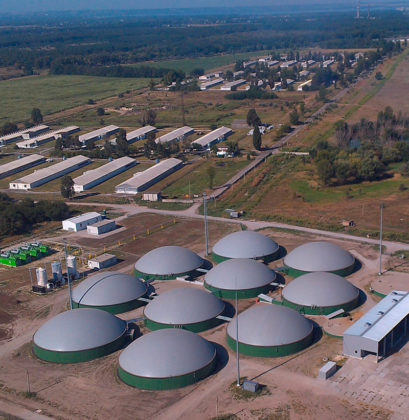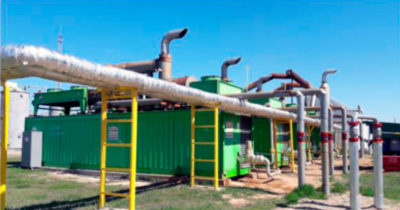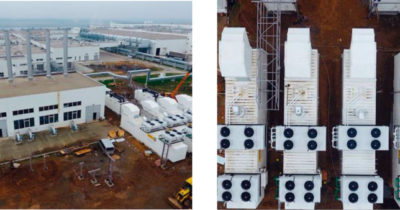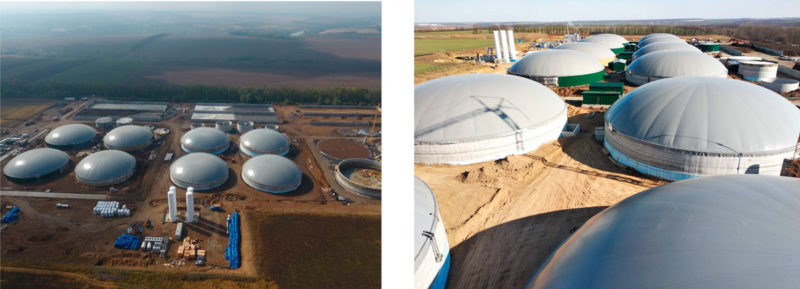Ivan Traksler, director of MHP Eco Energy and the first in Ukraine 5.7 MW biogas complex in his speech at the IV Seminar of Sustainable Agribusiness Forum (SAF Ukraine) described the main points that need to be moved so that the biogas complex was successful and worked on design capacity.
According to him, in order to correctly construct and start the biogas complex (BC) from the idea to the result it is necessary to fulfill a number of prerequisites, namely: to design and construct the BC, adhering to all requirements concerning the quality of materials, insulation and technological equipment; to correctly organize the process of start-up and adjustment of the first biogas; to get the biogas to the proper quality before submission to the cogeneration unit; to bring the cogeneration unit to the design capacity and to control the main parameters of the stable functioning of the biogas complex on a daily basis.

Biogas Complex PJSC “Oril-Leader”. Put into operation in 2013
The main indicators of the work of BC PJSC “Oril-Leader” for 2013-2018
- 300 000 tonnes – Chicken litter utilized
- 700 000 m3 – Sewage utilized
- 100 million m3 – Biogas produced
- 200 million kWh – Electricity generated
- 700 000 tonnes of CO2 eq. – Greenhouse gas emission reduction
- 100% – Сhicken litter processing
Design and construction of a biogas complex
Before starting the design phase, it is important to take into account all aspects of the location of the future biogas complex, says Ivan Traksler. In order to maximize the use of available resources, it is necessary to take into account existing communications and networks, such as a pipeline for the transmission of heat energy to remote customers or a steam pipe for the supply of steam produced. Logistic features of delivery, storage, and control of the amount of input raw materials play an equally important role. Logistics of raw materials supply should be minimal and should be done very quickly and efficiently. Optimal placement of fermenters and other technological equipment of the BC will help to reduce the operating costs of the BC. At the construction stage, high-quality building materials should be used in accordance with construction standards (quality of concrete, thickness, quality of insulation, quality of pipelines, etc.), and also provide for the installation of measuring equipment at all stages of production for the subsequent proper operation of the BC. Stages on which you want to “save” can further stop the process and cost much more, – emphasizes Director of “MHP Eco Energy”.

Biogas Complex PJSC “Oril-Leader”
Start-up and adjustment of the first biogas for reaching the planned capacity
Start-up and adjustment of the first biogas for reaching the planned capacity is the most complicated stage in the implementation of the biogas complex project, which requires qualified specialists. BC service personnel, biotechnologists, and operators must undergo preliminary training for effective management, timely response and elimination of problems that will arise in the complex. The necessary component of the BC is the availability of laboratory equipment, which will allow daily assessment of the composition of the input raw material, performance indicators of the fermenter, quality of gas, as well as correct and timely adjust them. At the stage of commissioning, it is important to have a program for reaching the planned capacity and strictly observe it, providing BC with a sufficient quantity of raw materials of the proper quality.

Separate division “Biogas Ladyzhyn”, 24 MW. The first in Ukraine tanks with a diameter of 41 m, a height of 6.5 m, with a working volume of 8000 m3
Achievement of qualitative indicators of biogas
As noted by Ivan Traksler, the first biogas obtained after the start of the process is not yet fully consistent with the qualitative indicators necessary for the operation of the cogeneration unit.

Cogeneration modules at PJSC “Oril-Leader”
Biogas must undergo a process of desulphurization in order to reduce the hydrogen sulfide content, which, for example, for a chicken litter can be about 4000 ppm in the fermentor, to the level of 100-200 ppm recommended by the producers of cogenerators. The achievement of the maximum production figures of a biogas complex depends on the process set for the entire project volume, which for large capacities can reach more than hundreds of thousands of cubic meters per day. Transportation of biogas to cogeneration requires its drainage and heating to avoid condensation and minimize losses of biogas. At Ladyzhyn station for the transport of biogas to the cogeneration unit, a 10 km long pipeline was built.
Cogeneration

Cogeneration modules at Separate division “Biogas Ladyzhyn”
The use of cogeneration modules also has its own nuances. In particular, in addition to reaching the maximum amount of electricity production, it is also necessary to optimize electricity consumption for own needs and take into account the possibilities of using heat energy. Upon completion of the commissioning and works on the grid connection in accordance with the TU, as well as the testing of cogeneration units with a gradual increase in capacity and access to stable generation, it is necessary to continue to carry out constant daily monitoring of compliance with the established parameters of the biogas complex.
Ensuring a stable functioning
The stable functioning of the biogas complex depends on the input raw material, the quantity and quality of which must be strictly controlled. To do this, it is necessary to carry out daily laboratory studies, the results of which make appropriate changes in the technological process to maintain a stable production of biogas. Equally important is the creation of a spare parts unit, which will help in the organization of timely maintenance of main equipment and measuring instruments, as well as emergency repairs.

Separate division “Biogas Ladyzhyn”. The first queue with 12MW installed capacity is the largest biogas complex for processing chicken manure in Europe. Commissioning.
Answering questions from participants in the Seminar on the handling of fermentation products, Ivan Traksler noted that 80-85% of the liquid fraction of the fermented mass is returned to the process, while the rest are exported and used as biofuels.
More presentations from IV Seminar of Sustainable Agribusiness Forum (SAF Ukraine) that was held on April 11 and was devoted to biogas technologies You can view here.
For reference: MHP Eco Energy is a Kyiv region enterprise, which started its activity in 2012. Mainline of activity: implementation and management of energy projects. The company is part of the structure of the Mironivsky Hliboproduct (MHP) agroindustrial holding.